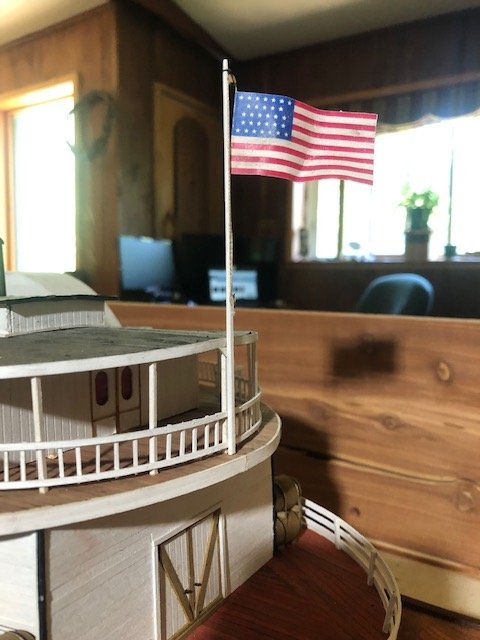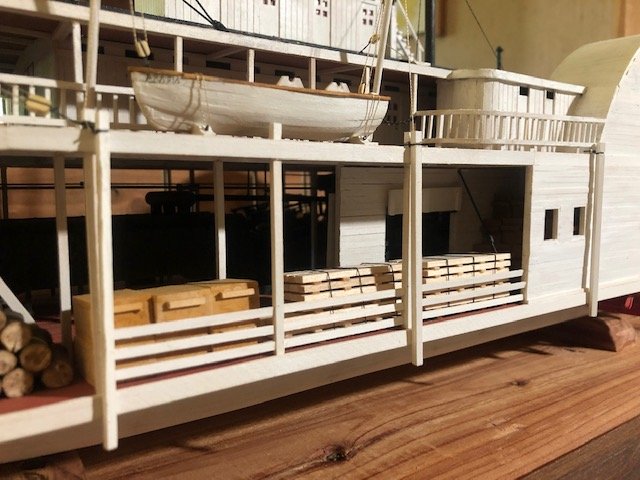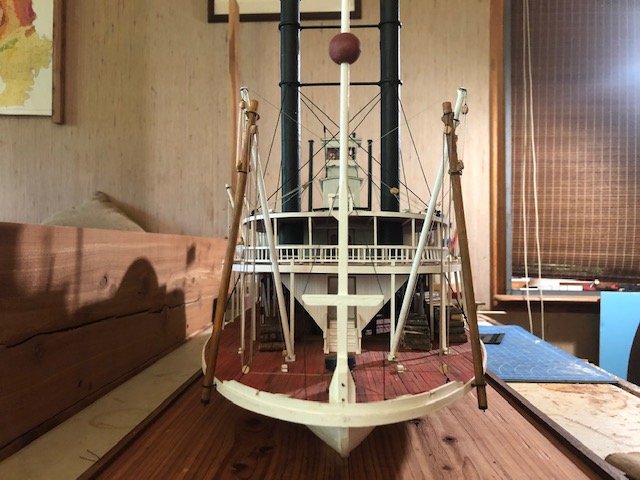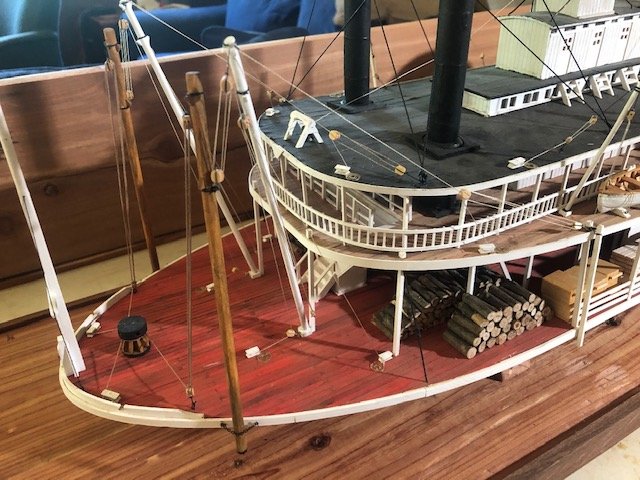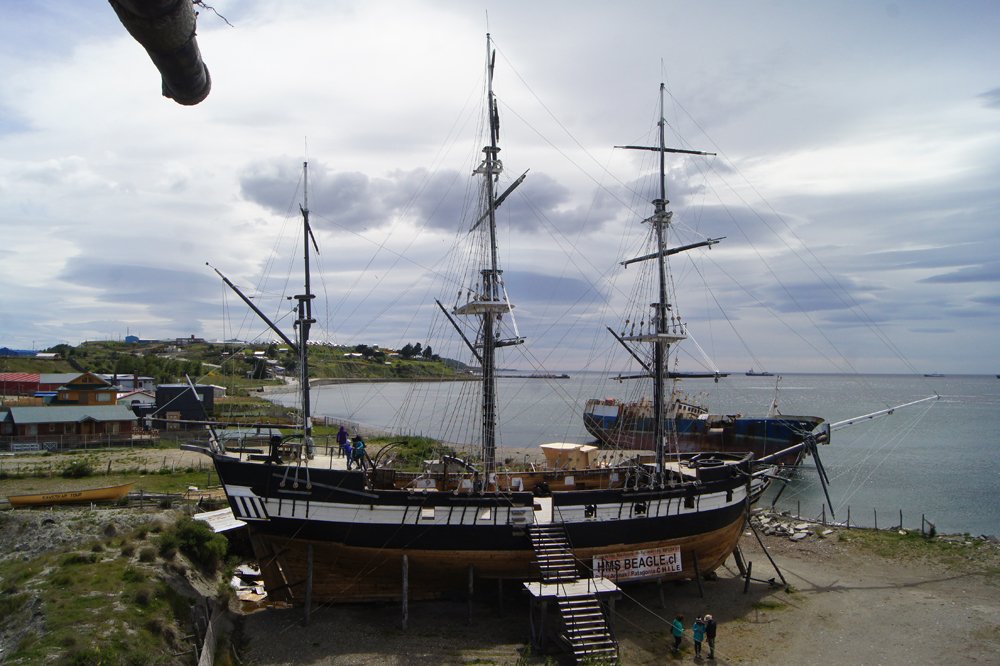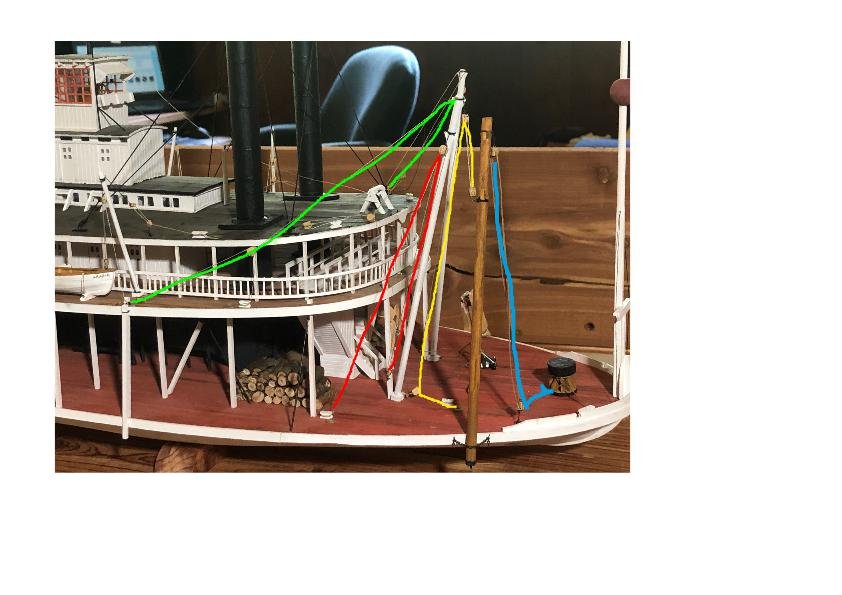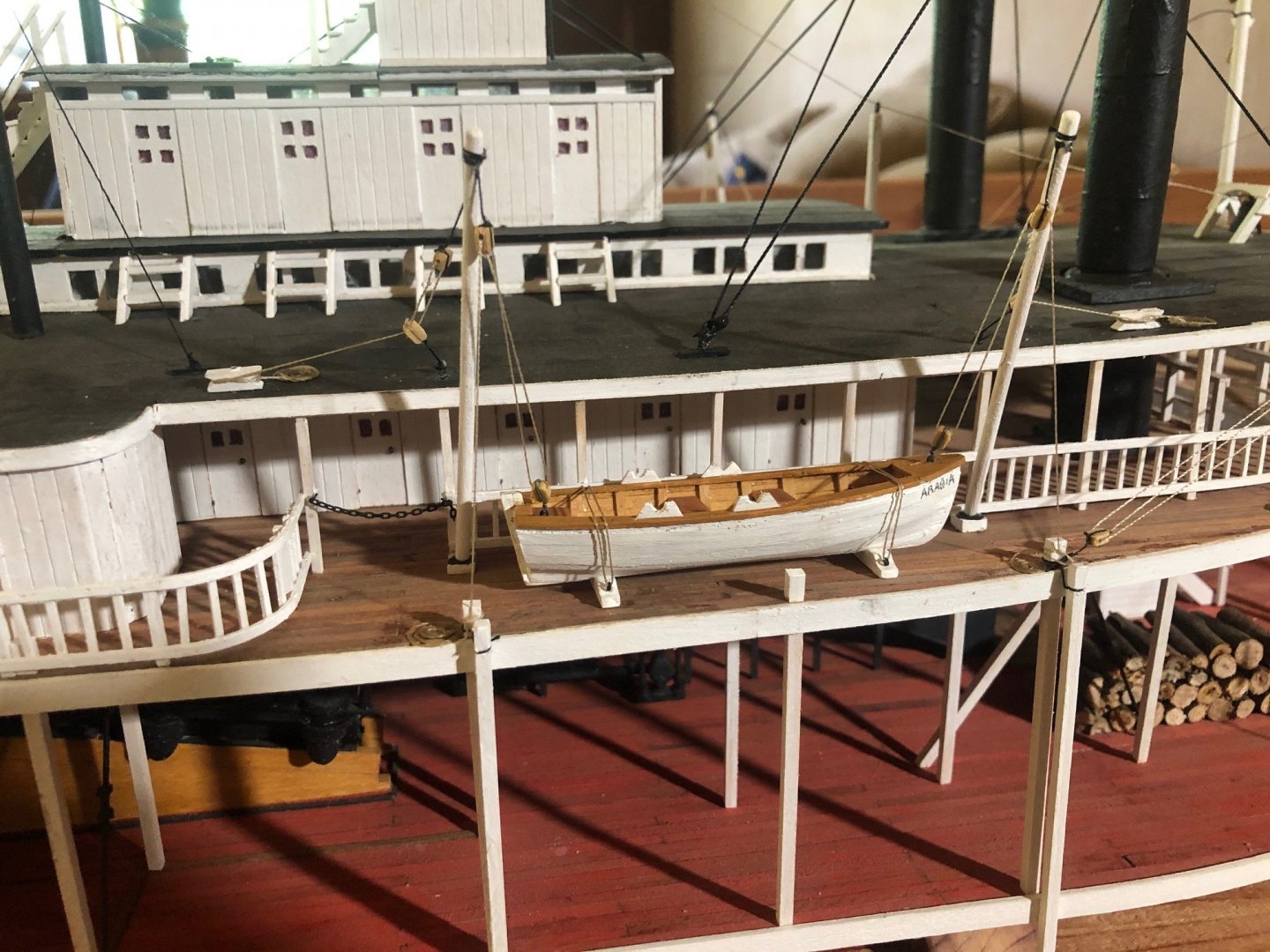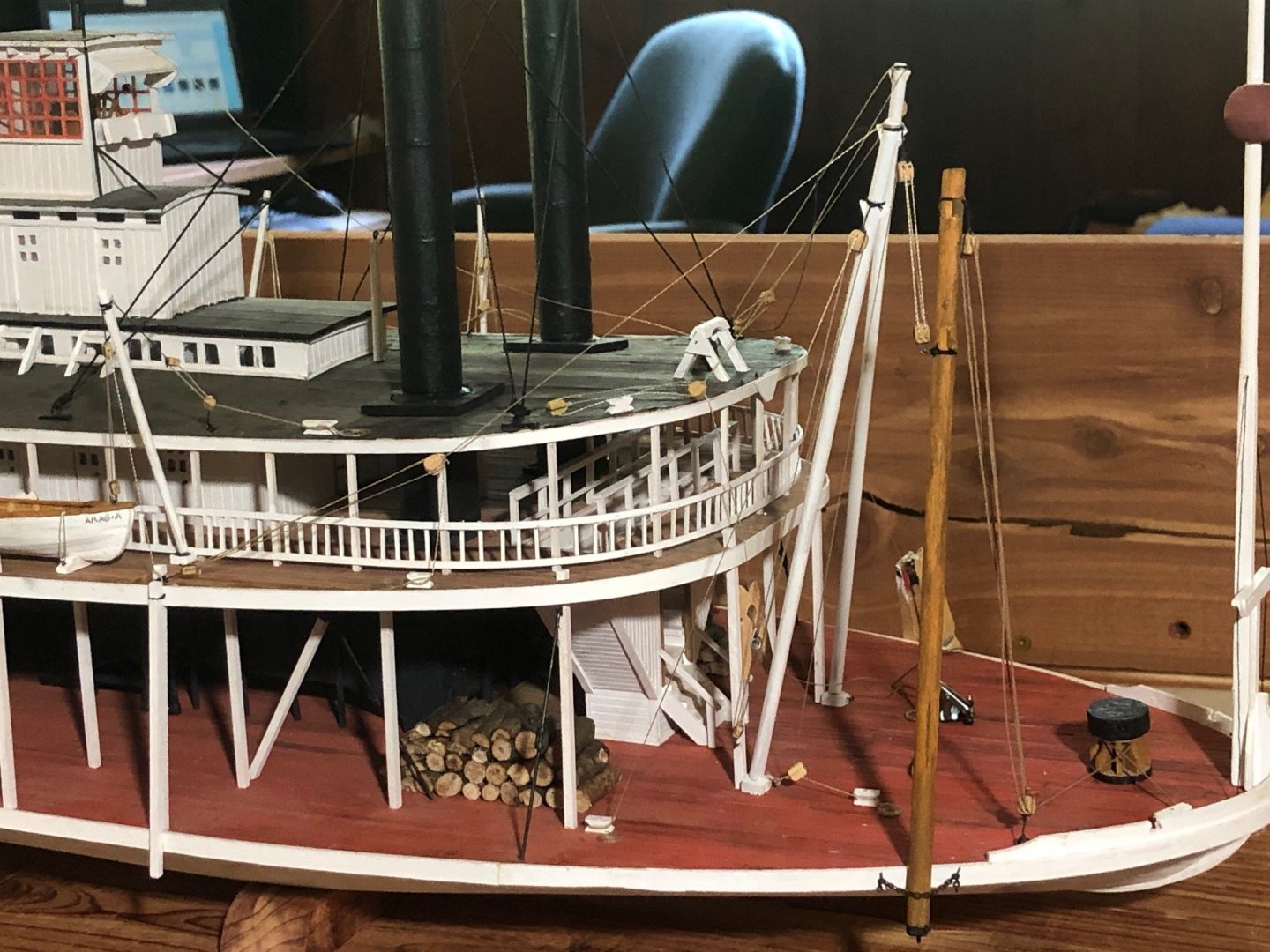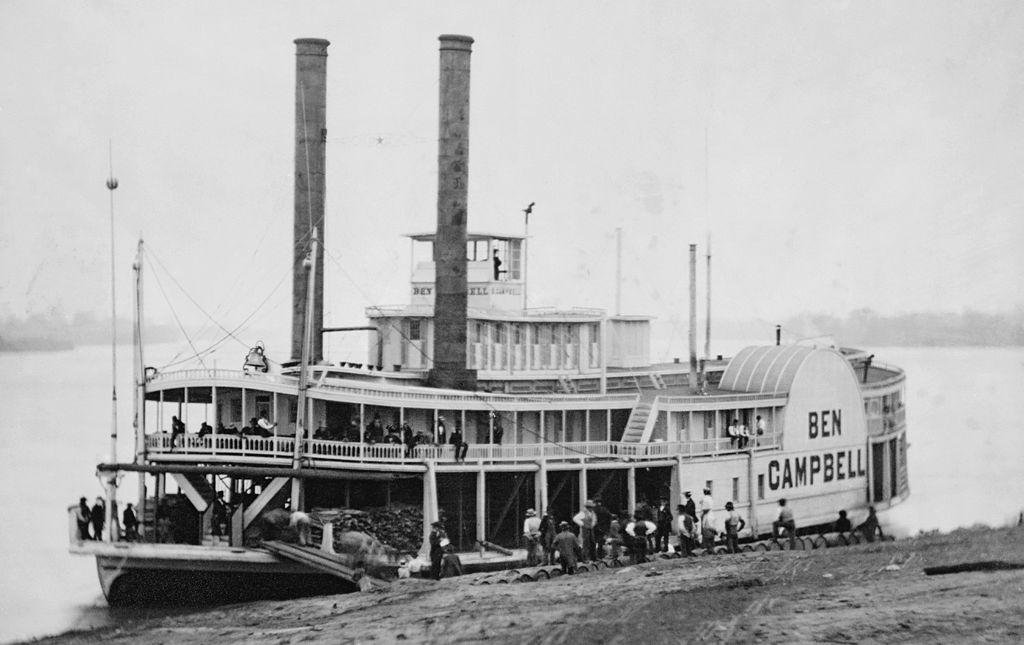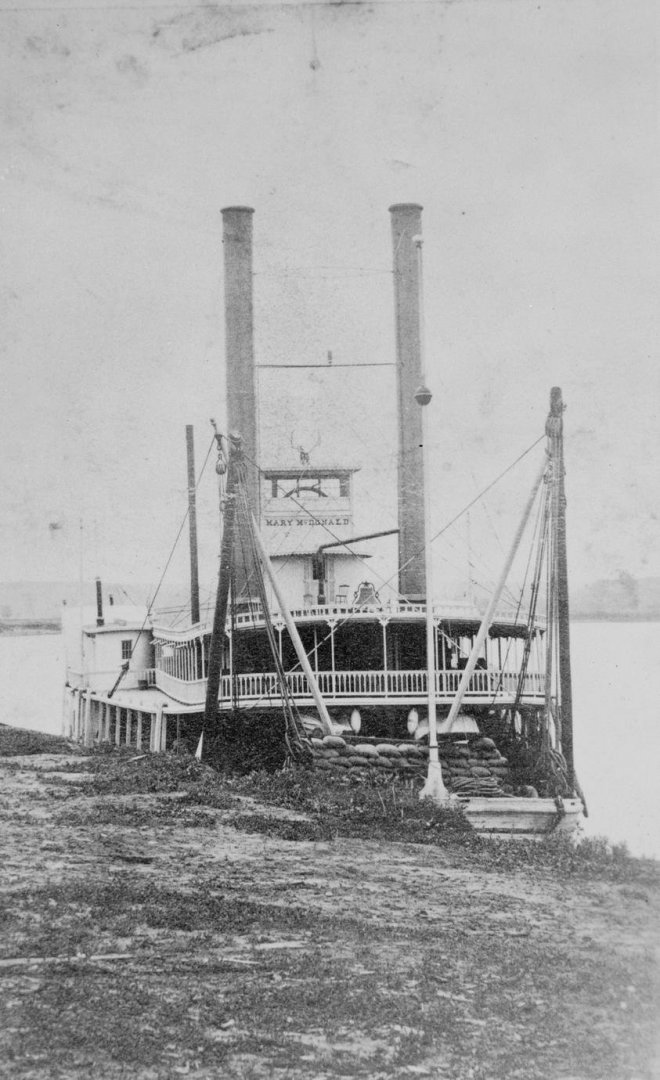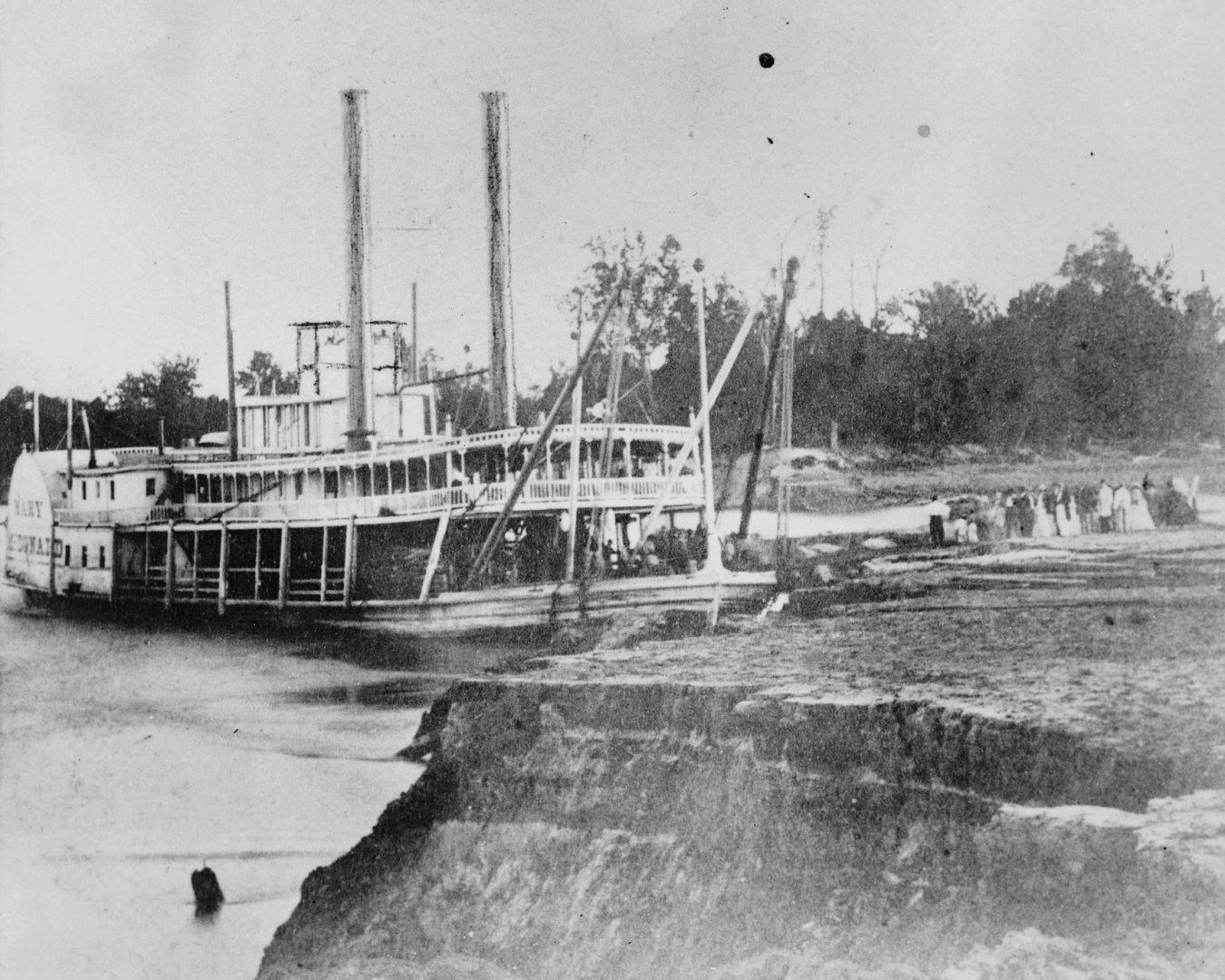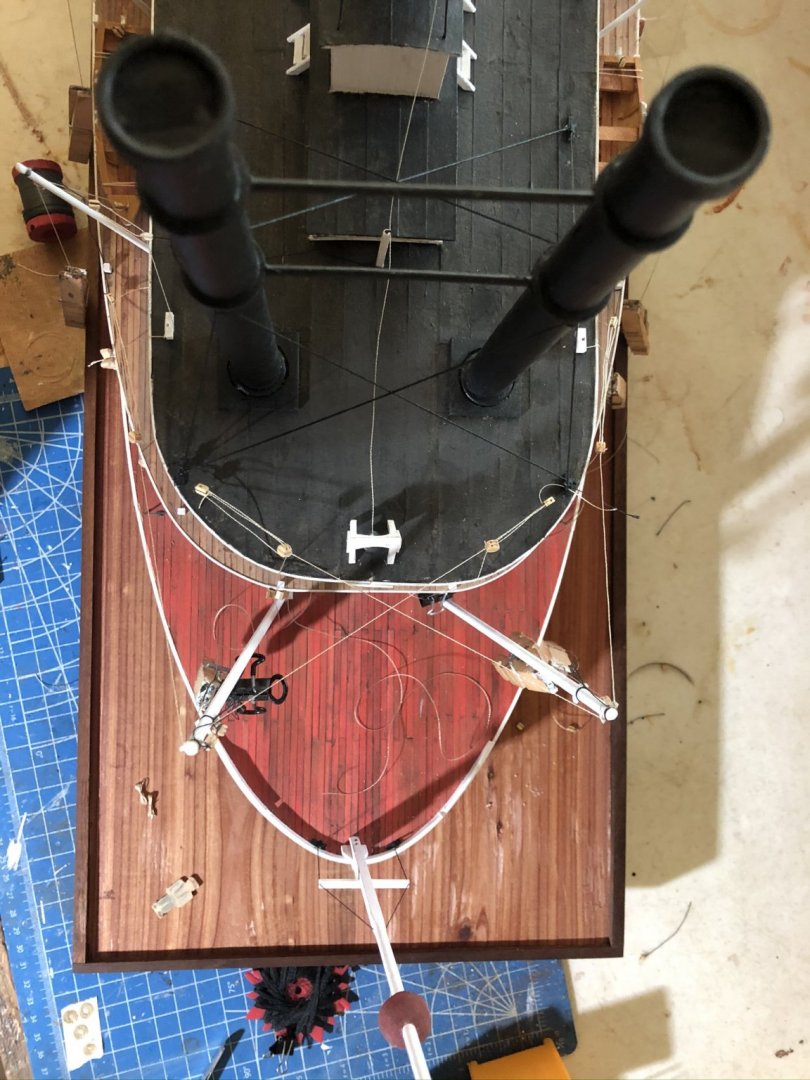-
Posts
3,482 -
Joined
-
Last visited
Content Type
Profiles
Forums
Gallery
Events
Everything posted by Cathead
-
A real ship's hatches would likely be aligned to fit between the regular deck beams to eliminate the problem you describe.
-
Roger, thanks so much. That means a lot coming from you. You've been such a help and inspiration as I learn more about steamboats over the years and you've helped me hold myself to a higher standard (though I still have a ways to go). Brian, I was thinking (hoping?) that I could get an inexpensive plexiglass case made that would fit over the model and inside the raised lip around the wooden base. I was thinking of contacting a few sign-making shops that seem to do various such work. Anyone have a smarter idea?
- 599 replies
-
- sidewheeler
- arabia
-
(and 4 more)
Tagged with:
-
Keith, I do have my next project selected, but am keeping it under wraps for now until I can truly declare this one done. Some may be disappointed to learn that it is not another riverboat; after 2.5 years of this complex scratchbuild, and under the higher level of stress I'm currently under for various reasons, I needed something simpler that someone else wrote directions for. Will reveal once I'm ready. I think it'll be fun. In the meantime, anyone looking for a new riverboat scratchbuild should head on over to Brian's just-started USS Cairo, which promises to be fascinating. John, that sounds really cool and I'd love to follow along. When you get started, feel free to drop a note in here so we can all be in on it from the beginning.
- 599 replies
-
- sidewheeler
- arabia
-
(and 4 more)
Tagged with:
-
Port rigging is done: Bow view: I added a few final details. For example, there should be a series of posts hung from the sides to protect the vessel. These are similar in function to the tires commonly used by more modern tugs and other vessels. It was common on more busy waterfronts (like St. Louis) for steamboats to line up shoulder-to-shoulder, making these barriers necessary. Photos show a variety of setups, from posts integrated into the hull to those hung loosely from lines. I opted for the latter; you can see the lines tied off to structural posts if you look closely. A spot of glue at the lower end of each post holds it in place as these aren't dense enough to hang right on their own. For example, here's a view of the St. Louis levee in 1852 from the Steamboat Times website: For the final detail, I added a flagpole and flag to the sternmost part of the hurricane deck, rigging it using a small block. This is the 31-star flag used from 1851 to 1858, following the admission of California to the Union. As Arabia was built in 1853 and sank in 1856, the choice of flag was clear. I printed it on bond paper as a single front-and-back image that could be folded over itself with glue between. I did this with a line carefully inserted along the seam, then rubbed some grey pastel on to dull the paper. I think it has a good texture, and between the weight of the paper and the glue, it takes and holds a decent wavy bend. Notice MSW on the laptop in my home office, set in the opposite corner of our small living room from my workbench. Here's the contemporary drawing I based the flagpole on, from the UW steamboat photo database: Those are all the final details, save one: I want to redo the lettering on the wheelhouse. Something had been bugging me about it, and I finally realized that it came out smaller than I intended. I compared the 3D-printed stencil with my initial paper test print and found that the stencil was quite a bit smaller than it was supposed to be. Can't believe I didn't notice up front. Somehow the design shrank in the transfer from my graphics program to the file used for printing. So I contacted the neighbor's teen again and he's going to ensure that the final design is scaled properly before printing a new one. So once I get my hands on that, I'll paint over the original lettering and redo it. Then she'll be done. This might take until next week, so not sure when I'll do a final photo shoot. I want to do one here under the right outdoor lighting conditions (not too sunny) and I also want to take a walkaround video. My final goal is to take the model down to the Missouri River and do a photo shoot with her natural habitat in the background. Also not sure when I'll get to that; the best place to do this is at a conservation area about 45 minutes from me. Stay tuned just a little bit longer. Thanks for all your support, comments, and likes.
- 599 replies
-
- sidewheeler
- arabia
-
(and 4 more)
Tagged with:
-
Nemo, It's the Nao Victoria museum in Punta Arenas, Patagonia. I was going to link their site but it's down; see Wikipedia instead. See this post and the next few in my Chile thread for a series of photos; I can provide more if you're looking for details of a given area. Here's one photo for inspiration: You're right that it's not a good idea to post emails publically, but you can contact members privately through the site. Click on someone's name and go to their profile page. There's a fairly obvious "Message" button that lets you send private messages (usually called PMs around here) in which it's safe to exchange emails, etc. By the way, as my avatar suggests, I love your helper! EDIT: I'm not expert enough to judge the absolute accuracy. But the ship is littered with plans, and I got the impression they were shooting for a reasonably level of accuracy. Can't promise any detail is right. It's rather a Quixotic endeavor, mostly one guy's dream project.
-
Oh, wow, I've dreamed of building this ship! I grew up not far from where she sank and have a signed copy of the book about her (and the subsequent discovery efforts). I always thought I'd have to scratchbuild this, but now maybe not? Someday... Meanwhile, I strongly recommend the book (linked to by an earlier poster) as very well written and quite interesting for anyone interested in the design, construction, and operation of sailing vessels on the Great Lakes (some noticeable differences with marine conditions).
-
I've never built a double-planked hull, but general guidance suggests that wood glue is far superior to CA for holding wooden pieces. You've done a good job so far, your methods for plank bending are similar to my own. You're right to want to shape the planks first, and only glue them on when they're already formed and have minimal stress. Also, a few years ago I visited a museum in southern Chile which featured a full-scale replica of the Beagle. I took lots of photos, as this is on my model life list as a geologist, so would be happy to share if you'd find them interesting as references or simply inspiration. EDIT: Meant to add, there's a lot of planking tuturiols and other guidance in the dedicated section here on MSW: https://modelshipworld.com/forum/14-building-framing-planking-and-plating-a-ships-hull-and-deck/
-
Thanks, John. If there's interest, I'll do another diagram from the bow view once the port side is done.
- 599 replies
-
- sidewheeler
- arabia
-
(and 4 more)
Tagged with:
-
Starboard rigging is done. This took quite a while, as there were so many details to work out regarding just how some of the lines should be run. I also had to make a lot of little rope coils. Final arrangement of starboard yawl: Final arrangement of starboard spar and grasshopper pole: Below is a diagram showing how all the lines work. I thought this might be of interest since (a) they’re hard to follow in photos and (b) it might not be obvious to many folks. I can’t promise this arrangement is “right”, but it’s based on looking at lots of photos and working out for myself what might make sense operationally. Anyway, as already determined, there was no one way of doing almost anything on these boats, so there’s a lot of modeler’s discretion. Note that I added the capstan as well, which would be needed to operate many of these lines. Green: Lines controlling the spar/boom. Adjusting these allows this to be raised, lowered, or swung. One line goes from the tip of the spar to each side of the superstructure, crossing in the middle. Note that the port spar isn’t fully rigged yet, so ignore the lines leading there as they’re not tightened or finalized. Red: Lines for a cargo hoist. Lower end is a dangling block with a cargo hook, currently hooked into a ring on the post closer to the central stairway. Took this idea from a drawing of the Far West and the previous discussion regarding having a way to move regular heavy loads around. This runs up to a block hung from the spar, then down to the cleat near the firewood pile. Can be run over to the capstan if needed. Yellow: Lines suspending the grasshopper pole from the regular spar. These let the grasshopper pole be raised or lowered while dangling from the spar. Runs from a cleat on the deck through several blocks. Should be used with the capstan. Blue: Lines allowing the boat to be hoisted over a bar using the grasshopper pole. Currently rigged from the capstan through a block on the deck, then up to the top of the grasshopper pole. When this is tightened, the whole boat can be lifted on that pole. I have this rigged with the grasshopper ready to deploy, hanging from the side. The lower end could be roped or chained in place; I liked the look of a chain. I found a note in Steamboats on the Western Rivers stating that the poles were "usually carried in an upright position on the main deck at either side just forward of the upper works", as done here. Using the grasshopper system would involve the following steps. It's my impression that both grasshoppers were used simultaneously, presumably by wrapping both lines around the capstan, but I'm not 100% sure of this. Swing the pole(s) over the side (green lines) if not already dangling there, as it is here Let pole(s) drop to river bottom (Ioosen yellow lines), presumably not very far if the bow is grounded on a sandbar Tighten blue lines using capstan. This hauls the whole bow upward since the pole(s) is(are) jammed into the river bottom Put engines on full forward, forcing the boat forward in a lurching up, sideways, down motion, like someone swinging over the top of crutches. Repeat as necessary until far enough over the bar that the engines can drive the boat forward. A given cycle might only move the boat forward a few feet and need to be repeated many times to get over a bar. Stow the pole(s) again by reversing steps 3-1. Steamboat hulls had to be very flexible for this to work; a hard keel like that on a sailing ship would snap during this operation, but the long steamboat hull could flex in multiple directions like a snake. This was one purpose of the iron hog chains running along and across the hull; these braced the hull and allowed for such flexing. Steamboats on the Western Rivers also notes that one boat in 1867 had to set spars 132 times on a downriver voyage from Montana to Missouri, with the crew in a state of near-mutiny by the end. At least the Arabia had a steam capstan; before this development grasshoppering involved lots of crew turning the capstan by hand, rather dangerous given the huge tension on the lines.
- 599 replies
-
- sidewheeler
- arabia
-
(and 4 more)
Tagged with:
-

New Young Model Builder from Minnesota LOOKING FOR ADVICE
Cathead replied to Kenna's topic in New member Introductions
Kenna, Good questions. I would say that any standard set of exacto blades should work fine; I use different shapes for different purposes but you don't need anything fancy. Sharpness is the most important factor, as a dull blade can crush or deform the very thin and fragile wood you'll be working with. As for glue, I use standard carpenter's wood glue for all my models, which is pretty benign. I hate fumes and work within my living room. This is all you should need for everything except maybe rigging (I use small droplets of CA to set knots). Although there is some debate about glues, it seems generally true that wood glue sets and holds wood especially well and should not degrade over time (some have suggested that CA does not age well). Wood glue is also easier to keep where it is put, while CA has a bad habit of soaking into wood and discoloring it or otherwise altering its appearance and performance. Moreoever, wood glue is easy to clean up from and to dissolve if you need to undo a mistake. As you're trying to avoid fumes, I'd also note that paints vary widely in this regard. I've found that Model Shipway's line of paints are very benign in terms of fumes and I use these exclusively. As with wood glue, I can work with these in my small living room and not bother myself or my wife (both of us are very sensitive to chemicals). I'd suggest reading through a few of the tutorials presented elsewhere on MSW regarding basic skills in hull preparation and planking before you get started. This isn't always intuitive even to people otherwise skilled in woodcraft (it wasn't to me when I got started) and understanding the concepts may really help you. Kit instructions often assume a certain level of knowledge on the builder's part that can be frustrating if you proceed blind. I know we're all trying to "tell you what to do", so please remember to have fun figuring it out for yourself, too! We're all very excited for you and just want to ease your journey. I hope you'll consider starting a build log here on MSW to track your progress with the Golden Hind kit, where you can continue to ask questions and share your progress. It's a really rewarding way to build a model. I couldn't have gotten started in this hobby without the advice and support I got from folks here on MSW. -
EDIT: re. ccoyle, I did mean wood glue, though good point about the slowing-curing CA. I personally hate using CA both because of the fumes and because of its tendency to ruin wood as you noted. It's fine for setting knots but I really don't like using it on wood as it never seems to stay where it's put. I've read some people talk about using wood glue for most of the joints and a few spots of CA just to hold the plank in place while the wood glue dries, but have never tried that. Original answer: There are a variety of very small clamps that can be purchased inexpensively from various sources. You can also make your own from small binder clips. In addition, I find that normal carpenter's wood glue sets up pretty fast (within a few minutes) when it is spread thinly between two pieces and held tight. This is especially true if you run a thin bead of glue along the plank edges, not just at the ribs. I can set a plank on a small boat like that with such glue, hold it in place with my fingers, and let go after a short wait. Fingers are the best clamps possible as they're infinitely adaptable and don't mar the surface. I still use clamps when I can to make life even easier, but I don't mind using fingers, especially if I just watch or listen to something while working to occupy my mind during the wait. If using wood glue, you should let it cure longer before stressing it, but it'll hold a plank in place pretty quickly. This works best if you soak and pre-bend the plank so there's less tension on it. See my recent build log for two 3" boat kits from Model Shipways for ideas and the following photos: Note the mini-clothespins in the background here, these are very useful: Might not work for everyone, just sharing how I've done it.
-
Wish I had any insight to contribute. Maybe contact a mod to see if NRG has more contact info than is publically available?
-
Fantastic. I'll be eagerly following along, though I don't know much about these vessels so won't be of much help. I have a lot of family an hour from Vicksburg and it's a really impressive place to visit for many reasons. Thanks for sharing this build with us.
-
I think you're the only one that can answer that, given the specific personal context of why you're doing this and what the model is intended for.
-

New Young Model Builder from Minnesota LOOKING FOR ADVICE
Cathead replied to Kenna's topic in New member Introductions
Just ask Gustavus Adolphus. -

New Young Model Builder from Minnesota LOOKING FOR ADVICE
Cathead replied to Kenna's topic in New member Introductions
How long a model takes partly depends on how much time you have to devote to it. If the two of you are in lockdown with little else to do, or plan on focusing on this as a primary activity for a long summer vacation, it won't take you hearly as long as I suggested. But others, even retired folks, can take years to build a single model depending on their time and abilities. I'm just pointing out that lots of newcomers to wooden kit building underestimate how complex the process is; it's not the same as basic plastic model building where you just follow steps gluing preformed pieces together. If your goal for the ordered kit is just to learn from it, have at it and have fun. Certainly the fact that you've built canoes gives you a big head start in terms of understanding something about how wood bends and the complex geometry of curved hulls. Now that you have the model (or will soon), I'd say give it a try and see how it goes; from there you can decide how to balance that project and your real goal. If you feel like it's too much, set it aside and try a small dory instead; you can always come back to the more complex model when you feel more confident and experienced. My responses (and those of others like Bob) are informed by the heartbreak of seeing too many new modellers jump in over their head, get frustrated, and quit the hobbby again rather than taking the time to develop their skills and work up to their dream project. It's probably overwhelming to gets lots of different advice; we all have different perspectives but we all care a lot about helping newcomers to this beloved hobby of ours, especially younger folks. -
That makes sense too, especially as my version looks more like sockets than hinges!
- 599 replies
-
- sidewheeler
- arabia
-
(and 4 more)
Tagged with:
-

New Young Model Builder from Minnesota LOOKING FOR ADVICE
Cathead replied to Kenna's topic in New member Introductions
Ron & Kenna, I think it would be helpful to clarify (to yourselves and those here) what level of detail you're trying to achieve, as you've partially done above. Until I saw Bob's response, I was planning an answer asking how accurate you were trying to be. For example, you could make a basic representative galleon with highly simplified details that would look cool, but without getting bogged down in "reproduction". A lot of folks here tend to think that model building inherently means super-detailed and highly accurate, but it doesn't have to be that way, and you shouldn't be discouraged by the false idea that model building is museum quality or nothing. For what I think you're trying to achieve, I think you're on the right track. You're clearly describing a large (but not people-carrying) vessel that's fun to play with in a lake but isn't meant to be a detailed replicate. Given that, I'd think upsizing plans is a reasonable idea as long as you're up for adapting them to your intended design. That being said, the smaller model may actually be harder to build because it is intended for builders making super-detailed accurate models and those take a LOT of skill that takes time to develop. If you don't care about a level of accuracy involving the actual ribs (and I suggest that you shouldn't), Bob's right that you may want to think of this as a skiff tricked out as a galleon, even if you do build it from scratch rather than grafting on to an existing boat. If you want to use a model to practice, you might be best off with a simple model (something like the beginner skiffs or ship's boats sold by BlueJacket or Model Shipways) that would teach you the rudiments of hull shaping, planking, etc. The Dusek model may prove more of a distraction than a guide because it may take you years to complete when that isn't really your goal. Just my two cents. I've never done something like you're attempting, but have taken the journal from beginner to moderately skilled builder, and am thrilled that you're (a) interested at all and (b) asking questions and learning rather than just diving in headlong. I hope we can give you all the encouragement and help possible in this very cool project. -
Ooooh, is that an ACW ironclad? Tantalizing.
- 133 replies
-
- chaperon
- model shipways
-
(and 2 more)
Tagged with:
-
Brian, that is indeed what I simulated, except I didn't make a full socket. They're actually mounted on wire pins inserted into the block below. I wouldn't be surprised if they were actually on hinges (to minimize sideways movement) but I don't know, wasn't sure how to simulate that accurately, and this was good enough for my purposes. I wanted them to move so I could adjust them to a final tension, so needed something flexible (not just glued in at a certain angle). As you said, it's really hard to figure out and I just went with modeller's license on this one. Technically the base wood is eastern red cedar, which is really a juniper species rather than a proper cedar. It's everywhere here and you must have a bunch in your neck of the woods, too. The base woods are finished with wood oil, and I agree I really like how the cedar color complements the red/brown tones of the model. The swirling coarse grain and knots evoke river water, too, at least I think so.
- 599 replies
-
- sidewheeler
- arabia
-
(and 4 more)
Tagged with:
-
Steve, good eye and good question. Yes, I want them rigged vertically as if she's navigating in the middle-upper Missouri and needs them at a moment's notice. I think you're referring to the jackstaff (tall pole on the bow), and I agree that the rigging lines I have there there would get in the way of resting the grasshopper poles on those jackstaff crosspieces. But it seems that different boats stored their poles in different ways. Based on past discussions in this thread, the Ben Campbell seems to have rested them horizontally on crosspieces on the jackstaff, like this: In this approach, you're right that any rigging on the jackstaff would get in the way. But the Mary McDonald didn't have a cross-wise brace on the jackstaff and had rigging lines running along it. Instead, she seemed to simply tilt the grasshopper poles back a bit and rest their ends on the deck. See below: I'm not sure what she did if/when she needed to use the spars as loading cranes, maybe just set the grasshopper poles on the deck or something, or maybe they just swung out with the spar. But as I'm using the Mary McDonald as my closest reference, and I want the grasshoppers displayed deployed, I went with this arrangement. One difference between these arrangements might be the area of operations. The higher up the Missouri you go, the less likely you're going to be handling heavy cargo with the spars and the more likely you're going to need the grasshoppers. In addition, the higher winds and less cover mean you need more rigging to support things like the jackstaff. So to me, the Mary McDonald looks like she's set up to be an upper-river boat emphasizing regular use of the grasshoppers, while the Campbell looks like it's mostly operating on the lower river and has grasshoppers stowed for occasional use. I want my Arabia to look more like the former, so will emphasize grasshoppers at the ready. This is all just my theory, but it seems plausible to me.
- 599 replies
-
- sidewheeler
- arabia
-
(and 4 more)
Tagged with:
-
The starboard rigging went a lot faster this morning, likely because I'd spent much of yesterday figuring out how to do it on the port side, whereas this time I just had to copy what I'd done before. I feel like photos really struggle to capture rigging because the lines are so thin and the three-dimensional framework doesn't translate well into a flat photo. Overhead view of the spar rigging. Two lines lead to the tip of each spar, controlling how it moves around the deck: Here's another view of this: The loose blocks hanging off the spars are for rigging the grasshopper poles and for general cargo use. These will be rigged next. Starboard boat rigging: All of this is still loose (hence all the dangling weights). I think I have it the way I want it, meaning I can start gluing in knots, but likely not until tonight or later as I have other things to do this afternoon. So here's your chance to comment if something doesn't look right!
- 599 replies
-
- sidewheeler
- arabia
-
(and 4 more)
Tagged with:
About us
Modelshipworld - Advancing Ship Modeling through Research
SSL Secured
Your security is important for us so this Website is SSL-Secured
NRG Mailing Address
Nautical Research Guild
237 South Lincoln Street
Westmont IL, 60559-1917
Model Ship World ® and the MSW logo are Registered Trademarks, and belong to the Nautical Research Guild (United States Patent and Trademark Office: No. 6,929,264 & No. 6,929,274, registered Dec. 20, 2022)
Helpful Links
About the NRG
If you enjoy building ship models that are historically accurate as well as beautiful, then The Nautical Research Guild (NRG) is just right for you.
The Guild is a non-profit educational organization whose mission is to “Advance Ship Modeling Through Research”. We provide support to our members in their efforts to raise the quality of their model ships.
The Nautical Research Guild has published our world-renowned quarterly magazine, The Nautical Research Journal, since 1955. The pages of the Journal are full of articles by accomplished ship modelers who show you how they create those exquisite details on their models, and by maritime historians who show you the correct details to build. The Journal is available in both print and digital editions. Go to the NRG web site (www.thenrg.org) to download a complimentary digital copy of the Journal. The NRG also publishes plan sets, books and compilations of back issues of the Journal and the former Ships in Scale and Model Ship Builder magazines.



